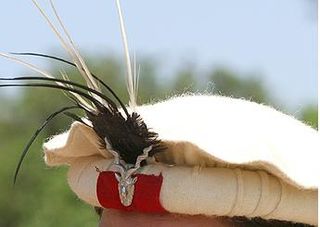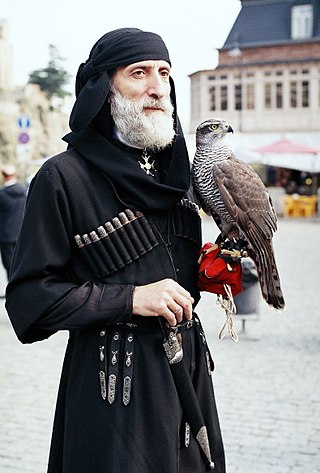Related Research Articles

A folk costume expresses a national identity through clothing or costume, which is usually associated with a specific region or period of time in history. It can also indicate social, marital, or religious status. If the costume is used to represent the culture or identity of a specific ethnic group, it is usually known as ethnic costume. Such costumes often come in two forms: one for everyday occasions, the other for traditional festivals and formal wear. The word "costume" in this context is sometimes considered pejorative due to the multiple senses of the word, and in such cases "clothing", "garments" or "regalia" can be substituted without offense.

The Culture of Pakistan is based in the Indo-Persian cultural matrix that constitutes a foundation plank of South Asian Muslim identity. The region has formed a distinct cultural unit within the main cultural complex of South Asia, Middle East and Central Asia. There are differences in culture among the different ethnic groups in matters such as dress, food, and religion, especially where pre-Islamic customs differ from Islamic practices.

Kho kho is a traditional Indian sport that dates back to ancient India. It is the second-most popular traditional tag game in the Indian subcontinent after kabaddi. Kho kho is played on a rectangular court with a central lane connecting two poles which are at either end of the court. During the game, nine players from the chasing team are on the field, with eight of them sitting (crouched) in the central lane, while three runners from the defending team run around the court and try to avoid being touched. Each sitting player on the chasing team faces the opposite direction of their adjacent teammates.

Khowar, or Chitrali, is an Indo-Aryan language primarily spoken in Chitral and surrounding areas in Pakistan.

The pakol or pakul is a soft, flat, rolled-up, round-topped men's cap, usually worn in Afghanistan and Pakistan. It is typically made of wool and found in a variety of earthy colours, such as brown, black, grey, ivory, or dyed red using walnut. The pakol is believed to have originated in Chitral, or Gilgit-Baltistan in Pakistan.

Punjabi culture grew out of the settlements along the five rivers which served as an important route to the Near East as early as the ancient Indus Valley civilization, dating back to 3000 BCE. Agriculture has been the major economic feature of the Punjab and has therefore formed the foundation of Punjabi culture, with one's social status being determined by landownership. The Punjab emerged as an important agricultural region, especially following the Green Revolution during the mid-1960's to the mid-1970's, has been described as the "breadbasket of both India and Pakistan". Besides being known for agriculture and trade, the Punjab is also a region that over the centuries has experienced many foreign invasions and consequently has a long-standing history of warfare, as the Punjab is situated on the principal route of invasions through the northwestern frontier of the Indian subcontinent, which promoted to adopt a lifestyle that entailed engaging in warfare to protect the land. Warrior culture typically elevates the value of the community's honour (izzat), which is highly esteemed by Punjabis.

A chokha, also known as a cherkeska, is a woolen coat with a high neck that is part of the traditional male dress of peoples of the Caucasus. It was in wide use among Avars, Abazins, Abkhazians, Eastern Armenians, Azerbaijanis, Balkars, Chechens, Circassians, Georgians, Ingush, Karachays, Nogais, Ossetians, Tats, the peoples of Dagestan, as well as Terek and Kuban Cossacks who adopted it from the aforementioned peoples.

The Kho or Chitrali people, are an Indo-Aryan ethnolinguistic group native to the Chitral District in Khyber Pakhtunkhwa and the Gupis-Yasin and Ghizer districts in Gilgit-Baltistan of Pakistan. They speak an Indo-Aryan language called Khowar.

The Indian subcontinent is a physiographical region in Southern Asia, mostly situated on the Indian Plate, projecting southwards into the Indian Ocean from the Himalayas. Geopolitically, it spans major landmasses from the countries of Bangladesh, Bhutan, India, Maldives, Nepal, Pakistan, and Sri Lanka. Although the terms "Indian subcontinent" and "South Asia" are often used interchangeably to denote the region, the geopolitical term of South Asia frequently includes Afghanistan, which is not considered part of the subcontinent.

Pakistanis are the citizens and nationals of the Islamic Republic of Pakistan. According to the 2017 Pakistani census, the population of Pakistan stood at over 213 million people, making it the world's fifth-most populous country. The majority of Pakistanis natively speak languages belonging to the Indo-Iranic family.

Shalwar kameez is a traditional combination dress worn by women, and in some regions by men, in South Asia, and Central Asia.

The Kho(ཁོ) is a traditional dress worn by Bhutia, ethnic Sikkimese people of Sikkim and Nepal. It is a loose, cloak-style garment that is fastened at the neck on one side and near the waist with a silk or cotton belt similar to the Tibetan chuba and to the Ngalop gho of Bhutan, but sleeveless.
A Choga is a long sleeved robe that is worn loosely around the bodice amongst Rajasthani men.

In the ancient Punjab region, people wore cotton clothing. Both men and women wore knee-length tops. A scarf was worn over the tops which would be draped over the left shoulder and under the right. A large sheet would be further draped over one shoulder which would hang loose towards the knees. Both male and female wore a dhoti around the waist. Modern Punjabi dress has retained this outfit but over its long history has added other forms of dress.

The traditional clothing and accessories worn in Khyber Pakhtunkhwa varies according to the area of the region. The following outfits are generally worn in the area, starting to north to south:

Choga denotes one of two traditional nature-friendly house types in Korea. The main building materials used to build these houses are straw, wood and soil.

Upper Chitral District (Khowar: توری ݯھیترارو ضلع)(Pashto: پورتنۍ چترال ولسوالۍ) is a district in the province of Khyber Pakhtunkhwa, Pakistan. Chitral River flows throughout the district.
Puttoo was the coarse woolen cloth used in and before the 19th century in the Indian subcontinent. It was made of camel's hair or yak.

India has several traditional games and sports, some of which have been played for thousands of years. Many of these games do not require much equipment or playing space. Some traditional Indian games are only played in certain regions of India, or may be known by different names and played under different rules and regulations in different regions of the country. Many Indian games are also similar to other traditional South Asian games.

South Asia has many traditional games and sports. Two of them, kabaddi and kho-kho, are played at the South Asian Games, with kabaddi also featuring at the Asian Games. Many of these games are played across the entire subcontinent under different names and with some rule variations, while some of these games may be played only in certain countries or regions.
References
- ↑ Durand, Algernon. The Making of a Frontier. Thomas Nelson & Sons.
Choga
- ↑ Staley, John. Words For My Brother. Oxford University Press. p. 277.
Choga
- ↑ "Chitrali Garment Chugha". Philamuseum. Retrieved 7 November 2023.
- ↑ "Chitrali Chugha". tribune. Retrieved 7 November 2023.
- ↑ "Chugha Traditional Chitrali Garment". woonlenways. Retrieved 7 November 2023.